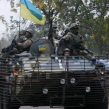
Ukraine Grants More Powers to Localities in Russian-Controlled Territory (Part One)
Publication: Eurasia Daily Monitor Volume: 11 Issue: 165
By:

On September 16, the Ukrainian parliament approved a “Law on the special procedure of local self-administration in individual districts in Ukraine’s Donetsk and Luhansk provinces” (Russian version’s terminology: poryadok, samo-upravlenie, raiony). Those two provinces of Ukraine are now, de facto, partitioned into Russian-controlled and Ukrainian-controlled zones. The law applies temporarily to Ukraine’s territory controlled by Russian military and proxy forces. The September 5 ceasefire protocol had prescribed for Ukraine to confer a special status on that territory by law (see EDM, September 10, 11).
Submitted urgently by President Petro Poroshenko, the law passed with 277 voting in favor, out of 336 deputies attending (from a total membership of 450). Those opposed simply did not vote, according to reports from this closed-door session. The law had to be rushed through, ahead of the parliament’s recess for pre-term elections due on October 26 (Unian, Zerkalo Nedeli zn.ua, September 16, 17).
Given its link with an onerous ceasefire protocol, this draft law aroused widespread misgivings. Unusually, the Cabinet of Ministers did not participate in drafting this law; and some of the cabinet’s senior members criticized parts of it publicly (see below). Rather, the presidential administration drafted this law (full text in Ukraiynska Pravda, September 15). President Poroshenko had to work hard in parliament on the morning of September 16 to ensure a solid majority for passage of the bill without any significant changes (The Insider [Kyiv], September 16).
Contrary to those initial misgivings, the law’s final version in no way legitimizes the Donetsk and Luhansk “people’s republics” (DPR, LPR). The notion of a “special status” has been dropped, and does not occur in the text as adopted. The Ukrainian law’s notion of self-administration does not apply to the Donetsk province or Luhansk province, nor to the Donbas region (aggregation of the two), let alone to the DPR-LPR. The law applies, instead, to lower-level administrative units in the occupied territory. This legislation is designed to reach out to those local units directly, bypassing or ignoring the “central authorities” of the DPR and LPR. From the standpoint of not legitimizing the DPR and LPR, this Ukrainian law is airtight.
Whether this law can operate as intended, however, seems more than doubtful. Russia’s proxies installed in the administrative centers of Donetsk and Luhansk are strongly placed to control the lower-level administrative units directly, along vertical lines, in the occupied territory. Now partitioned by military demarcation lines (which have not yet fully stabilized), the Donetsk and Luhansk provinces form the most intensively industrialized part of Ukraine.
While avoiding the worst (i.e., any form of accepting the loss of territory), this law remains controversial in Kyiv’s body politic. The law, as adopted, enters into force upon official publication of its full text by the government. The extensive summaries made public by Ukrainian media have drawn strong criticism over ambiguities and loopholes in the law. Even some government officials are disavowing or reinterpreting parts of the adopted law (Ukraiynska Pravda, Ukrinform, UNIAN, Zerkalo Nedeli, September 15–18).
Adoption Mechanism
This law is an octroy, i.e., a unilateral grant of competencies from top down; in this case, from the central government to local administrative units in the occupied territory. Russia and its local proxies will almost certainly attempt to replace an octroy arrangement with a “mutually agreed” one, i.e. of a contractual nature, between Kyiv and the Donetsk-Luhansk authorities, so as to legitimize the latter. Kyiv should expect to face such demands after the parliamentary elections if not sooner.
Duration
The law’s applicability is limited to three years (without provisions for abridgment or prolongation of this term). Some Ukrainian officials (even two presidential advisors) suggest publicly that the law might not necessarily run the full three-year period, and might be terminated earlier, depending on the situation on the ground (Ukrinform, UNIAN, September 17, 18). This seems illusory, however. Russia will certainly insist on the prolongation of this law (or a Russian-amended version of it) after the first term of three years. Western powers (with Germany in the lead) are likely to support prolongation also, as part of the overall armistice arrangement and new “stability” in a conserved conflict.
Geographic Area
The law applies to the “localities geographically situated within the anti-terrorist operation (ATO) area,” i.e., the Ukrainian-defined theater of military operations. However, the ceasefire (and full-fledged armistice agreement to follow) will probably necessitate replacing the notion of “ATO area” with a more precise definition of the geographic area covered by this law.
This law uses the term “districts” [raions] in a generic sense (“self-administration in individual districts in the Donetsk and Luhansk provinces”). However, the Donetsk province is divided into 18 rural districts and 27 urban municipalities, plus the provincial administrative center Donetsk. The Luhansk province is divided into 18 rural districts and 13 urban municipalities, plus the provincial administrative center Luhansk. Moreover, this Ukrainian law applies to various types of administrative units there: cities, districts, municipalities, and villages (see below).
When signing the September 5 ceasefire, the Russian side controlled one third of the territory and one half of the population in the Donetsk and Luhansk provinces. Despite the ceasefire, Russian and proxy forces continue biting off portions from the Ukrainian-controlled territory. By the time the Ukrainian law enters officially into force, the Russians will certainly control more territory than was the case on the date of the ceasefire. They will probably try to expand into additional localities through political subversion after the full-fledged armistice. The Ukrainian military apparently intends to establish a fortified line of demarcation across the Donetsk and Luhansk provinces (sprotyv.info, September 15–18).




